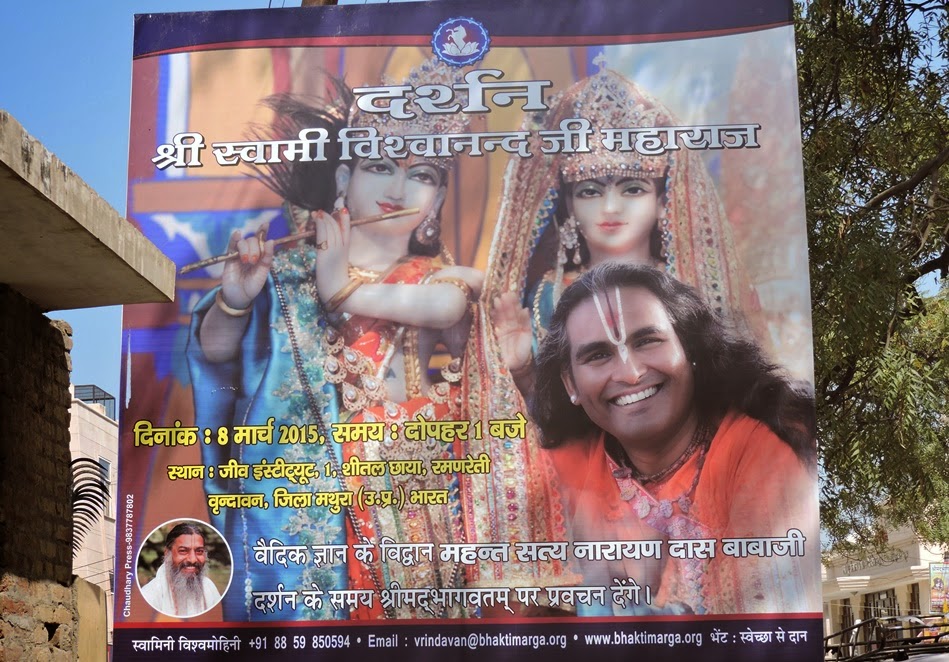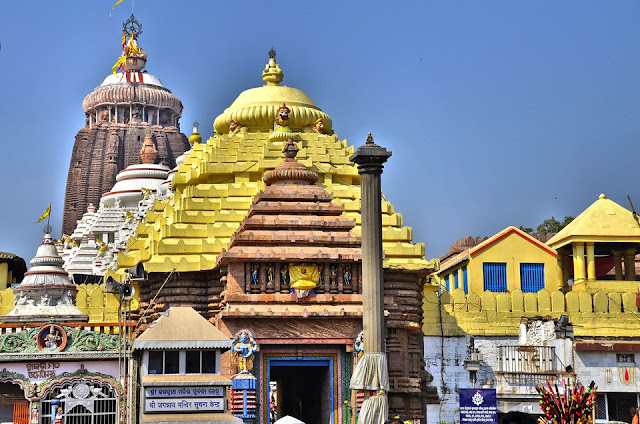More on Identity and Sadhana
A lot of what I write on this blog comes out of concern from seeing young devotee couples who are conflicted about their spiritual endeavors and their material engagements, especially their family relationships. The family can become a huge and pretty meaningless burden if the basis of it, namely the loving attraction between husband and wife, is felt to be outside the realm of direct sāsaṅga, svarūpa-siddha bhakti, which is really the ideal kind of practice for the sādhaka.
A busy working person has so many obligations, work, family, outside interests, that it becomes difficult to find a place for all the bhakti aṅgas. For married couples with children, what to speak of bhajana, even finding time for personal intimacy or making love often becomes difficult, and for many, it loses a lot of its charm because of that--it is hurried, obligatory, unsatisfying, even exhausting. It loses a lot of its meaning, even though we instinctively know that it is necessary in order to anchor the loving relationship in the center of the family unit. And this indifference is then mistaken for spiritual advancement, even though its repercussions are far from beneficial -- for the couple, for their children or for the extended family and community.
What I am trying to do is find a way to revive the sacred nature of love-making in the context of Gaudiya Vaishnavism, so that it becomes a part of sāsaṅga, svarūpa-siddha bhakti. That it confirms your inner identity as a servant of Srimati Radharani rather than being seen as an aspect of your material identity that is to be rejected.
The idea is that it should illuminate both your external, "material" (sādhaka-deha) and your inner, spiritual (siddha-deha) life. It seems perfectly obvious to me that unless a sacred character to human love can be recuperated from the current situation, the Krishna consciousness movement has a limited future. There is some understanding of the divine child in Krishna consciousness, even divine friendship and divine service, but they are all marginalized in favor of the ascetic model of spirituality. By recuperating a model of divine conjugal love, we can revitalize the entire community of devotees through the sanctification of the family unit. This is the core and the key.
I am beginning to realize that my most visible ideas are the tip of a pretty big iceberg and most people don't seem able to get it. I will try again today, starting with sevā sādhaka-rūpeṇa. Because that's where it all starts, with two bodies, two identities, two stories; one external, the other internal; one particular, the other universal.
It seems that every time I write a blog these days, I start out by saying that I have already talked about this before. Even so, I can see that the relationship of mañjarī bhāva and this lovemaking sādhana I am trying to explain is not clear to many people. To begin with, I get the distinct impression that very few people have any idea of mañjarī-bhāva-sādhana, what to speak of being actual practitioners. So in this respect, people are right when they say that my doctrines have a substantial problem of adhikāra.
sevā sādhaka-rūpeṇa siddha-rupeṇa cātra hi
tad-bhāva-lipsunā kāryā vraja-lokānusārataḥ
First of all, remark that the verse makes an immediate split in the personality. This is rather unusual, since in one sense we are all looking for a unicity or coherence to our identities, and this kind of splitting is what we are trying to avoid. At the very least, we are looking for a core identity that is the most authentic self, where we can take shelter.
As devotees, that research begins by defining ourselves as something other than the body, as spirit soul. But this information on its own is only the beginning, for even if we identify as soul, there is still a material identity that we lug around with us and have to deal with whenever we try to do something in this world. The sannyasi is someone who has, at least in part, solved this problem. But even there, this so-called "spiritual identity" is that of the sādhaka-deha, and it is accepted by all sādhakas as only a partial transformation thereof. The siddha-deha is about a further, internal transformation of identity.
This verse makes it clear that this splitting is somewhat inevitable. There is always going to be a mixture of identities and personalities in every person. That is one of the unavoidable complexities in life. We could define this split as one of the present personality and the other as the potential.
This is going on in everyone's mind, especially in the young, as they dream about their potential and goals in this life, whatever they are. In this case, though, we have not just one, but two potential personalities, one is the sādhaka, to which we are trying to conform in this body, the other is the siddha-deha, to which we are trying to conform internally.
Well, let's start with the sādhaka-deha. Now this verse says, vraja-lokānusārataḥ, which means "following in the footsteps of the residents of Vraja." So how should we understand this? The obvious meaning to most devotees is that of dressing like, behaving like, engaging in the same practices as, having the same ideals as, etc., Rupa Goswami and his followers, right up to and including our own gurus and devotee community. In other words, emulating these previous Vaishnavas, who have themselves appeared as sādhakas.
But let us try to understand this a little more in the context of the concepts of identity and identification. As a general rule, we know the basic principal that we are eternal servants of Krishna. That is a general rule, but it does not answer the specifics of our own lives. To a certain extent we get some of that from the models that come from the devotees we know and from the literature. Now, what is the function of a model, or a literary hero (nāyaka)? To understand this, we must understand a little more about rasa theory.
Rupa Goswami says that the sādhaka āśraya ālambana provides us with a literary model of the aspiring sādhaka. This means that there are stories about sādhakas that inspire us and enthuse us to follow the devotional life and its aspirations. In other words, there is a process of identification going on in the sādhaka-deha that contributes to our overall identity as devotees.
Generally speaking, these models are what we call archetypes. They do the kinds of things that we expect of them. They fit pretty much the perfect idea of the devotee. Even when talking about historical devotees like our direct gurus and their antecedents, we prefer to have an archetypal understanding of who or what they are. This is called hagiography. What does it mean to become a devotee? What happens when you get śraddhā? Basically, it means that you accept these models and you also, somehow or other, want to reenact those models, adopt these roles in your own life. For some, this takes the form of heroic asceticism, forty-day fasts in the desert and the such.
In our sampradāya, it is harder to find other kinds of models, but examples of householder life like Nityananda Prabhu, Advaita Acharya, the Goswamis in their descendance, and great personalities like Bhaktivinoda Thakur can still be found. In a way, I believe that we have been badly served by the marginalization of the householder model, and that is, in part, what we are trying to rectify.
The fact is that there is a psychological phenomenon that I call "auto-mythologizing," but which is called other things by other people. I have talked about this quite often, and you can see some of these things in the following posts: A Day Off; Automythology; Worst kind of teacher.
A busy working person has so many obligations, work, family, outside interests, that it becomes difficult to find a place for all the bhakti aṅgas. For married couples with children, what to speak of bhajana, even finding time for personal intimacy or making love often becomes difficult, and for many, it loses a lot of its charm because of that--it is hurried, obligatory, unsatisfying, even exhausting. It loses a lot of its meaning, even though we instinctively know that it is necessary in order to anchor the loving relationship in the center of the family unit. And this indifference is then mistaken for spiritual advancement, even though its repercussions are far from beneficial -- for the couple, for their children or for the extended family and community.
What I am trying to do is find a way to revive the sacred nature of love-making in the context of Gaudiya Vaishnavism, so that it becomes a part of sāsaṅga, svarūpa-siddha bhakti. That it confirms your inner identity as a servant of Srimati Radharani rather than being seen as an aspect of your material identity that is to be rejected.
The idea is that it should illuminate both your external, "material" (sādhaka-deha) and your inner, spiritual (siddha-deha) life. It seems perfectly obvious to me that unless a sacred character to human love can be recuperated from the current situation, the Krishna consciousness movement has a limited future. There is some understanding of the divine child in Krishna consciousness, even divine friendship and divine service, but they are all marginalized in favor of the ascetic model of spirituality. By recuperating a model of divine conjugal love, we can revitalize the entire community of devotees through the sanctification of the family unit. This is the core and the key.
I am beginning to realize that my most visible ideas are the tip of a pretty big iceberg and most people don't seem able to get it. I will try again today, starting with sevā sādhaka-rūpeṇa. Because that's where it all starts, with two bodies, two identities, two stories; one external, the other internal; one particular, the other universal.
It seems that every time I write a blog these days, I start out by saying that I have already talked about this before. Even so, I can see that the relationship of mañjarī bhāva and this lovemaking sādhana I am trying to explain is not clear to many people. To begin with, I get the distinct impression that very few people have any idea of mañjarī-bhāva-sādhana, what to speak of being actual practitioners. So in this respect, people are right when they say that my doctrines have a substantial problem of adhikāra.
tad-bhāva-lipsunā kāryā vraja-lokānusārataḥ
First of all, remark that the verse makes an immediate split in the personality. This is rather unusual, since in one sense we are all looking for a unicity or coherence to our identities, and this kind of splitting is what we are trying to avoid. At the very least, we are looking for a core identity that is the most authentic self, where we can take shelter.
As devotees, that research begins by defining ourselves as something other than the body, as spirit soul. But this information on its own is only the beginning, for even if we identify as soul, there is still a material identity that we lug around with us and have to deal with whenever we try to do something in this world. The sannyasi is someone who has, at least in part, solved this problem. But even there, this so-called "spiritual identity" is that of the sādhaka-deha, and it is accepted by all sādhakas as only a partial transformation thereof. The siddha-deha is about a further, internal transformation of identity.
This verse makes it clear that this splitting is somewhat inevitable. There is always going to be a mixture of identities and personalities in every person. That is one of the unavoidable complexities in life. We could define this split as one of the present personality and the other as the potential.
This is going on in everyone's mind, especially in the young, as they dream about their potential and goals in this life, whatever they are. In this case, though, we have not just one, but two potential personalities, one is the sādhaka, to which we are trying to conform in this body, the other is the siddha-deha, to which we are trying to conform internally.
Well, let's start with the sādhaka-deha. Now this verse says, vraja-lokānusārataḥ, which means "following in the footsteps of the residents of Vraja." So how should we understand this? The obvious meaning to most devotees is that of dressing like, behaving like, engaging in the same practices as, having the same ideals as, etc., Rupa Goswami and his followers, right up to and including our own gurus and devotee community. In other words, emulating these previous Vaishnavas, who have themselves appeared as sādhakas.
But let us try to understand this a little more in the context of the concepts of identity and identification. As a general rule, we know the basic principal that we are eternal servants of Krishna. That is a general rule, but it does not answer the specifics of our own lives. To a certain extent we get some of that from the models that come from the devotees we know and from the literature. Now, what is the function of a model, or a literary hero (nāyaka)? To understand this, we must understand a little more about rasa theory.
Rupa Goswami says that the sādhaka āśraya ālambana provides us with a literary model of the aspiring sādhaka. This means that there are stories about sādhakas that inspire us and enthuse us to follow the devotional life and its aspirations. In other words, there is a process of identification going on in the sādhaka-deha that contributes to our overall identity as devotees.
Generally speaking, these models are what we call archetypes. They do the kinds of things that we expect of them. They fit pretty much the perfect idea of the devotee. Even when talking about historical devotees like our direct gurus and their antecedents, we prefer to have an archetypal understanding of who or what they are. This is called hagiography. What does it mean to become a devotee? What happens when you get śraddhā? Basically, it means that you accept these models and you also, somehow or other, want to reenact those models, adopt these roles in your own life. For some, this takes the form of heroic asceticism, forty-day fasts in the desert and the such.
In our sampradāya, it is harder to find other kinds of models, but examples of householder life like Nityananda Prabhu, Advaita Acharya, the Goswamis in their descendance, and great personalities like Bhaktivinoda Thakur can still be found. In a way, I believe that we have been badly served by the marginalization of the householder model, and that is, in part, what we are trying to rectify.
The fact is that there is a psychological phenomenon that I call "auto-mythologizing," but which is called other things by other people. I have talked about this quite often, and you can see some of these things in the following posts: A Day Off; Automythology; Worst kind of teacher.
Generally speaking, automythology means creating a personal narrative that embodies a clear sense of identity, purpose and, above all, destiny. It means the active imagination to be the author of your own life story. For a devotee, it is about finding your own particularity as an individual, servant of God.
For the materialistic person, the same process is going on, but the goals are material in nature. The clearer one's personal story, the clearer that one can recognize the role God plays in our lives. Sometimes, it happens that there is an epiphany in a disordered and confused life that transforms it and gives it direction. But that simply makes one's personal story clearer. This is why so many ex-drug addicts and prostitutes write books about their experience and turn to helping others. Their transformation becomes the event that gives their entire lives meaning. This is also a significant element in guru tattva and what makes the guru so much more than a mere purveyor of words, an exemplar.
Now, and this is important in everything that I am saying, all of this shows that we as human beings, have this extraordinary ability to see our lives from a multiplicity of perspectives, to take that material and redirect it in accordance with a personal vision. We think that we are living our own lives freely and naturally, but in fact we are not. Mind, intelligence and ego are all playing this modelling role, and no one can excise mind, intelligence and ego from their being. Material or spiritual, these things are going to remain. If you want to live without mind, intelligence or ego, then be born as a rock.
Rasa in our own lives comes when we identify with our "self" in our own stories. We can define our story as one of success or failure, make it a horror story, a heroic tale, or a love story. As devotees, our lives other one hand are the story of us as sādhakas, structuring our lives in a way that recognizes the hand of the Divine in leading us to the lotus feet of our Lord, through the details of our lives. And we experience rasa when we recognize how grace enters our lives.
On another level, our lives are miniature, reflected manifestations of Krishna's own pastimes. How's that? Inasmuch as our lives are the stories of our relationships--as parents and children, friends and well-wishers, masters and servants, teachers and students, wives or husbands, lovers or mistresses--all of these are the pastimes of Krishna in miniature, or in reflection. Even where these relationships are material, they still reflect the divine relationships in Goloka, and to the extent that they approximate those divine relationships, they become openings into the spiritual world.
इति विज्ञाय राधे त्वं नय मां चरणान्तिके




Comments